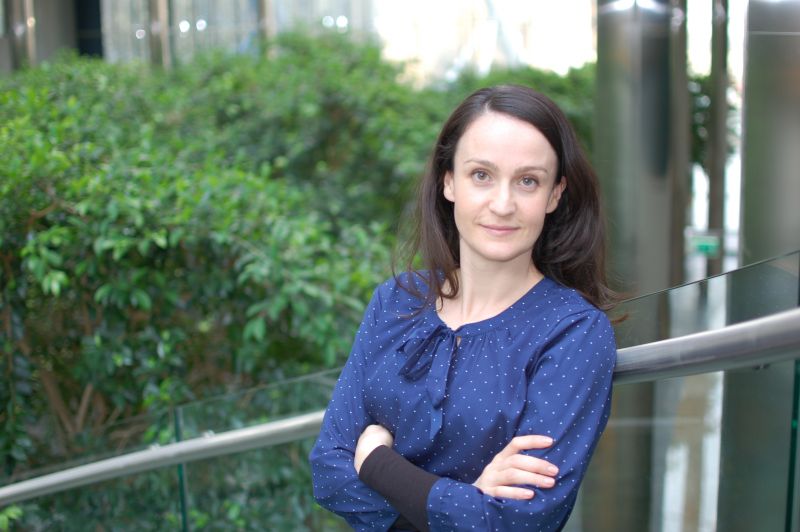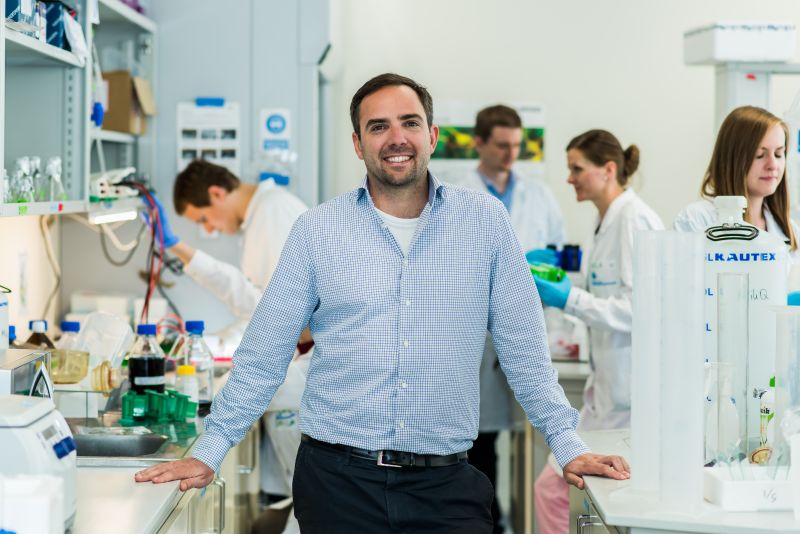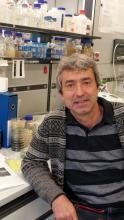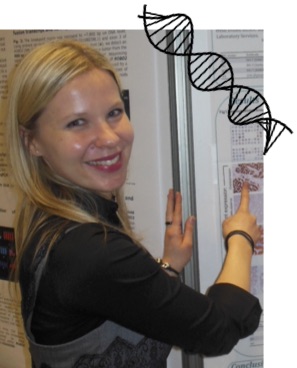Speaker: Dr. Pawel Zawadzki, Division of Molecular Biophysics, Adam Mickiewicz University Poznan, Poland
Talk: DNA repair processes as markers for personalized cancer therapies.
Time: 17th May 2019, 9:00 am
Venue: Intercollegiate Faculty of Biotechnology, Abrahama 58, hall 042
 Personalized medicine is an approach to improve treatment of an individual patient by taking into account specific changes in individual’s DNA. One aspect of this is an assessment of DNA repair mechanisms to tailor cancer treatment based on patient genomic profiles. Thus, evaluation of the efficiency of DNA repair provides a unique opportunity to apply targeted cancer therapies. We work on identifying DNA repair pathways involved in cell chemosensitivity by RNAi knockdown screening. We tested RNAi library for genes involved in different DNA repair pathways using the hTERT RPE-1 cell line. Silencing RNA interference (RNAi) of the target DNA repair gene was followed with various drug treatments to identify repair pathway-specific chemosensitivity. For example, we observed that silencing of Nucleotide Excision Repair but not Mismatch Repair drastically increase the sensitivity of the cells to popular chemotherapeutic – cisplatin. In conclusion, poor effectiveness of some repair pathways increase susceptibility to cisplatin. Obtaining this information for individual tumor can potentially help select most effective treatment for patients. We suggest that the comprehensive analysis of DNA repair pathways efficiencies, preferably achieved by cancer whole-genome sequencing could provide a diagnostic tool and should soon be applied in the day-to-day cancer diagnostics.
Personalized medicine is an approach to improve treatment of an individual patient by taking into account specific changes in individual’s DNA. One aspect of this is an assessment of DNA repair mechanisms to tailor cancer treatment based on patient genomic profiles. Thus, evaluation of the efficiency of DNA repair provides a unique opportunity to apply targeted cancer therapies. We work on identifying DNA repair pathways involved in cell chemosensitivity by RNAi knockdown screening. We tested RNAi library for genes involved in different DNA repair pathways using the hTERT RPE-1 cell line. Silencing RNA interference (RNAi) of the target DNA repair gene was followed with various drug treatments to identify repair pathway-specific chemosensitivity. For example, we observed that silencing of Nucleotide Excision Repair but not Mismatch Repair drastically increase the sensitivity of the cells to popular chemotherapeutic – cisplatin. In conclusion, poor effectiveness of some repair pathways increase susceptibility to cisplatin. Obtaining this information for individual tumor can potentially help select most effective treatment for patients. We suggest that the comprehensive analysis of DNA repair pathways efficiencies, preferably achieved by cancer whole-genome sequencing could provide a diagnostic tool and should soon be applied in the day-to-day cancer diagnostics.
Speaker: dr Anna Marusiak (CENT Warszawa)
Talk: Mixed-Lineage Kinase 4 (MLK4) – a new player in breast cancer progression
Time: 5th April 2019, 9:00 am
Venue: Intercollegiate Faculty of Biotechnology, Abrahama 58, hall 042

In December 2015 I started a position as a postdoctoral fellow at the Centre of New Technologies in the Laboratory of Experimental Medicine. The grants that I have been awarded, Fuga by NCN and Homing by FNP, allowed me to investigate the role of MLK4 in breast cancer progression. MLK4 is a serine/threonine kinase that plays a role in a variety of cellular processes. According to TCGA, amplification and mRNA upregulation of MLK4 is present in 23% of invasive breast carcinoma and our transcriptomic analysis revealed that it is most abundantly expressed in triple-negative breast cancer subtype. Nevertheless, the role of MLK4 in the pathogenesis of breast cancer has been poorly understood so far. My talk will focus on our recent data where we identified MLK4 as a novel therapeutic target for triple-negative breast cancer.
Speaker: dr Sebastian Glatt (Max Planck Research Group Leader z Małopolskie Centrum Biotechnologii UJ, Kraków)
Talk: Charging the Code - insights into tRNA Modification Enzymes
Time: 15th March 2019, 9:00 am
Venue: Intercollegiate Faculty of Biotechnology, Abrahama 58, hall 042
 My whole scientific career is driven by a deep fascination for the complex molecular mechanisms that allow cells to reproduce, adapt to changing environmental conditions and differentiate into specialized cell types by the activation of specific gene expression programs. These processes are particularly important in multi-cellular organisms, as each individual cell carries the identical genetic information, but needs to produce selected sets of proteins depending on the specialized function of the respective cell type and different external triggering signals. Protein synthesis can be subdivided into different successive processes, called transcription and translation, which are both susceptible to specific regulatory mechanisms. Whereas, transcription describes the production of mRNA molecules from activated genes by RNA polymerases, the subsequent process describes the translation of mRNA encoded sequence information into correctly assembled chains of linked amino acids. During the final step, these peptide chains fold into their correct and enzymatically active three dimensional structure due to their intrinsic properties or with the help of associated chaperoning factors.
My whole scientific career is driven by a deep fascination for the complex molecular mechanisms that allow cells to reproduce, adapt to changing environmental conditions and differentiate into specialized cell types by the activation of specific gene expression programs. These processes are particularly important in multi-cellular organisms, as each individual cell carries the identical genetic information, but needs to produce selected sets of proteins depending on the specialized function of the respective cell type and different external triggering signals. Protein synthesis can be subdivided into different successive processes, called transcription and translation, which are both susceptible to specific regulatory mechanisms. Whereas, transcription describes the production of mRNA molecules from activated genes by RNA polymerases, the subsequent process describes the translation of mRNA encoded sequence information into correctly assembled chains of linked amino acids. During the final step, these peptide chains fold into their correct and enzymatically active three dimensional structure due to their intrinsic properties or with the help of associated chaperoning factors.
During my doctoral thesis I have been studying the consequences of deregulated protein synthesis, leading to an overproduction of certain proteins that are essential for the development of human squamous cell carcinomas. During my postdoctoral time, I have been involved in different basic research projects that focused on understanding the fundamental structural and functional aspects of transcriptional and translational regulation. In detail, I have been studying the structure and function of specific and general transcription factors, which are needed to recruit RNA polymerases and activate gene transcription. In addition, I have been involved in the structural dissection of RNA polymerases themselves and so called chromatin remodelling complexes, which regulate the access of all the above described factors to their respective DNA binding sites in the context of the tight network of condensed chromatin. For most of the above mentioned projects, I have been involved through direct mentoring/supervision of PhD students or contributed my technical expertise in structural biology and protein biochemistry techniques.
My prime scientific interest focused on the structural and functional characterization of specific regulatory events of the translation machinery. In detail, the speed and continuity at which ribosomes move along mRNAs during the elongation phase of translation varies with the nucleotide sequence, influencing not only the rates but also the folding and stability of the emerging nascent polypeptide chains. As tRNA selection in the A-site of ribosomes is a rate-limiting step during elongation phase, the use of synonymous codons and specific base modifications in the wobble base position of tRNAs influences local elongation speed and aids co-translational protein folding. As errors in these tRNA modifications cascades are causing intellectual disabilities, neurodegenerative diseases and cancers in humans, they have caught my special attention over the last years. Therefore, my Max Planck Research Group at the MCB is continuing previous efforts to understand the structure and function of the highly conserved eukaryotic Elongator complex, responsible for conducting specific chemical modifications in the wobble base position of tRNAs. In detail, we use x-ray crystallography and electron microscopy to obtain snapshots of the involved proteins and try to deduce their biochemical activities from the observed structures. Subsequently, we employ different in vitro and in vivo approaches to validate and challenge our structure based working hypotheses. In addition, together with various national and international collaboration partners we have recently started to work on related tRNA modification pathways and other translation control pathways, that are important for stem cell maintenance and differentiation.
Last but not least, I would like to highlight that these cellular mechanisms under investigation are not only highly conserved, vaguely characterized and extremely complex, but are also of high clinical relevance and importance. Therefore, I believe that the results and scientific insights from our ongoing research projects will pave the way for the development of novel diagnostic and therapeutic strategies to improve the life span and life quality of the affected patients.
Speaker: dr Vittorio Venturi (International Centre for Genetic Engineering and Biotechnology (ICGEB),Trieste, Italy)
Talk: Interspecies signaling in plant associated bacteria
Time: 08th March 2019, 9:00 am
Venue: Intercollegiate Faculty of Biotechnology, Abrahama 58, hall 042

dr Vittorio Venturi graduated from Edinburgh University, UK, and received his Ph.D. degree in Microbiology from the University of Utrecht, The Netherlands. During his PhD research he focused in the regulation of iron-transport processes of beneficial plant associated bacteria which promote plant growth; the monopolization of iron nearby plant roots is an important trait which keeps microbial pathogens away. He then moved as a postdoctoral fellow to the International Centre for Genetic Engineering & Biotechnology (ICGEB), Trieste, Italy, where he started investigating intercellular signaling among bacteria. He then went on to become Group Leader at ICGEB continuing his studies on intercellular signaling. He has published over 140 research articles in peer-reviewed international journals. He is interested in (i) how plant associated bacteria undergo interspecies communication and interkingdom signaling with plants and (ii) plant microbiomes and the development of microbial products for a more sustainable agriculture https://www.icgeb.org/vittorio-venturi.html
Abstract: Just like what occurs in humans, plants have been recently recognized as meta-organisms possessing a distinct microbiome that have a close relationship with their associated microorganisms. The plant microbiome presents an additional reservoir of genes that the plant can have access to when needed. Plant health is thought to heavily depend also on its microbiome and signaling among microorganisms is crucial for the establishment of the microbial community. Understanding how bacteria undergo interspecies signaling in the microbiome will be a big challenge for future studies. We are using several rice diseases as a model of interspecies bacterial interactions, which also highlights their role in bacterial plant pathogenicity. In addition, we are designing experiments to begin to understand how beneficial plant associated bacteria communicate and establish multispecies communities. Understanding these signaling pathways will help in devising new ways for a more sustainable agriculture.
Speaker: Prof. Minna Pirhonen (University of Helsinki)
Talk: Soft rot bacteria and their interaction with potato
Time: 12th April 2019, 9:00 am
Venue: Intercollegiate Faculty of Biotechnology, Abrahama 58, hall 042
.jpg) Minna Pirhonen is an Associate Professor and University Lecturer at the Department of Agricultural Sciences, University of Helsinki, Finland and a supervisor for Doctoral Programmes in Microbiology and Biotechnology and Plant Sciences at University of Helsinki. Minna’s main research interest are connected to phytopathology, plant physiology, genetics and molecular microbiology. She is an author and coauthor of more than fifty research and review publications targeting different aspects of interaction of plant pathogenic and plant associated bacteria with their plant hosts as well as isolation and characterization of soft rot bacteria.
Minna Pirhonen is an Associate Professor and University Lecturer at the Department of Agricultural Sciences, University of Helsinki, Finland and a supervisor for Doctoral Programmes in Microbiology and Biotechnology and Plant Sciences at University of Helsinki. Minna’s main research interest are connected to phytopathology, plant physiology, genetics and molecular microbiology. She is an author and coauthor of more than fifty research and review publications targeting different aspects of interaction of plant pathogenic and plant associated bacteria with their plant hosts as well as isolation and characterization of soft rot bacteria.
Associate Professor Pirhonen was one of the first scientists (1993) to discover and describe that plant pathogenic bacteria communicate with each other in environment (the mechanism broadly known now as quorum sensing) and that they can globally coordinate their populational response during infection of the host. This fundamental work was a basis to understand that bacteria can be perceived as semi-multicellular organisms living under natural conditions in consortia and “talking to each other all the time”.
Speaker: Krzysztof Pyrć, PhD, DSc, JU professor (Laboratory of Virology, Jagiellonian University)
http://virogenetics.info/
Talk: Entry of human coronaviruses
Time: 25th January 2018, 9:00 am
Venue: Intercollegiate Faculty of Biotechnology, Abrahama 58, hall 042
 The virus entry is one of the key points of the infection, and cell/tissue susceptibility to a large extent determines the nature and severity of the disease. Using a variety of techniques we have mapped the route of entry for several coronaviruses, including human coronavirus NL63 and human coronavirus OC43. Available data on coronavirus’ entry originate frequently from studies employing immortalized cell lines or undifferentiated cells. Here, using the most advanced 3D tissue culture system mimicking the epithelium of conductive airways, we systematically mapped entry of viruses into susceptible cell. Considering low specificity of chemical inhibitors targeting different endocytic pathways, we decided to track the fate of a single virus particle in the cell with confocal microscopy. Obtained results were validated with developed 3D image analysis algorithms and subsequent statistical assessment.
The virus entry is one of the key points of the infection, and cell/tissue susceptibility to a large extent determines the nature and severity of the disease. Using a variety of techniques we have mapped the route of entry for several coronaviruses, including human coronavirus NL63 and human coronavirus OC43. Available data on coronavirus’ entry originate frequently from studies employing immortalized cell lines or undifferentiated cells. Here, using the most advanced 3D tissue culture system mimicking the epithelium of conductive airways, we systematically mapped entry of viruses into susceptible cell. Considering low specificity of chemical inhibitors targeting different endocytic pathways, we decided to track the fate of a single virus particle in the cell with confocal microscopy. Obtained results were validated with developed 3D image analysis algorithms and subsequent statistical assessment.
Our results show that HCoV-NL63 virions require endocytosis for successful entry, and interaction between the virus and the receptor molecule triggers recruitment of clathrin. Subsequent vesicle scission by dynamin results in virus internalization, and the newly formed vesicle passes the actin cortex, what requires cytoskeleton rearrangement. Finally, acidification of the endosomal microenvironment is required for successful fusion and release of viral genome into the cytoplasm. On the other hand, HCoV‑OC43 employed a very different route, using caveolin-1-dependent pathway to enter the cell. Surprisingly, the virus was also internalized by macropinocytosis, but this route of internalization did not allow for virus entry and subsequent replication. HCoV‑OC43 trafficking in the cell seems to be carried out along actin filaments. We believe that usage of 3D tissue culture models and an appropriate methodology allowed us to obtain reliable, relevant biological results.
Speaker: dr Sivakumar Vadivel Gnanasundram (French Institute of Health and Medical Research)
Time: 16th November 2018, 9:00 am
Venue: Intercollegiate Faculty of Biotechnology, Abrahama 58, hall 042
.jpg) Dr. Gnanasundram finished his Master’s degree in Microbiology from the University of Madras, India in 2008. He then moved to Indian Institute of Science, India as a Research fellow and worked on novel anti-viral therapeutics using small RNAs targeting Hepatitis C virus RNA translation. For his doctoral degree he enrolled into HBIGS, Heidelberg University, Germany where he worked on Ribosome biogenesis pathway and RNA helicases. He completed his doctoral degree in 2014. For his post-doctoral work he moved to Dr. Robin Fåhraeus group at INSERM, Paris, France.
Dr. Gnanasundram finished his Master’s degree in Microbiology from the University of Madras, India in 2008. He then moved to Indian Institute of Science, India as a Research fellow and worked on novel anti-viral therapeutics using small RNAs targeting Hepatitis C virus RNA translation. For his doctoral degree he enrolled into HBIGS, Heidelberg University, Germany where he worked on Ribosome biogenesis pathway and RNA helicases. He completed his doctoral degree in 2014. For his post-doctoral work he moved to Dr. Robin Fåhraeus group at INSERM, Paris, France.
His present work involves in understanding the oncogenic mechanisms of the Epstein-Barr virus (EBV)-encoded EBNA1. It has been known for over 50 years that EBV is a human oncogenic virus responsible for app. 2-3% of all cancers but unlike other oncogenic viruses, the underlying molecular oncogenic mechanisms of EBV have largely remained obscure. Transgenic mice models have shown a reverse correlation between the expression of the EBNA1 protein and a lymphoma phenotype. Why less of an oncogenic protein would give more cancer could not be explained until now. It turns out that EBNA1 suppresses its own synthesis in cis in order to minimize the production of antigenic peptides for the MHC class I pathway and thereby helps the virus to evade the immune system. His work that is recently published in Nature Communications shows that the stress caused by this suppression of translation leads to the activation of E2F1 and the induction of c-myc. We speculate that the virus is exploiting a cellular pathway whereby cells senses dysfunctional mRNA translation and compensates by inducing ribosomal biogenesis via c-myc.
Speaker: dr Ryan O'Shaughnessy (University of London)
Talk: Discovering multiple roles for AKT1 in skin barrier function and skin disease
Time: 19th October 2018, 9:00 am
Venue: Faculty of Chemistry, hall F8

Dr Ryan O'Shaughnessy is a Senior Lecturer in the Centre for Cell Biology and Cutaneous Research. He leads a research programme focused on understanding molecular mechanisms of skin barrier function and through these insights, developing new therapies for diseases of skin barrier function, with particular emphasis on the ichthyoses, eczema and skin cancer.
Ryan completed his PhD in keratinocyte biology at Cancer Research UK, before postdoctoral training at Columbia University, NY and Queen Mary University of London. He started his skin barrier laboratory in 2008 at the UCL Great Ormond Street Institute of Child Health, and in 2012 was the Academic Lead of the Livingstone Skin Research Centre, a research centre dedicated to the study of childhood skin disease. He was awarded a Society of Investigative Dermatology Kligman fellowship in 2002 and the British Society of Investigative Dermatology Young Investigator Award in 2009.
Memberships include the European Society of Dermatological Research and the European Epidermal Barrier Research Network, and the UK Translational Research Network in Dermatology (UK TREND) and he is on the Editorial Board of Experimental Dermatology and on the Committee of the British Society of Investigative Dermatology.
Speaker: dr Paweł Leźnicki (University of Manchester, Manchester, United Kingdom)
Talk: Protein deubiquitylation controls the degradation of mislocalised secretory and membrane proteins and regulates endoplasmic reticulum function
Time: 23th November 2018, 9:00 am
Venue: Intercollegiate Faculty of Biotechnology, Abrahama 58, hall 042
.JPG)
The ubiquitin-proteasome system is the predominant degradative route for the disposal of defective and/or unwanted proteins in eukaryotic cells. Polypeptides destined for the proteasome-mediated degradation are most often initially marked by covalent conjugation of a small polypeptide, ubiquitin. Ubiquitin can form polymers (ubiquitin chains or polyubiquitin) linked via lysine residues or the N-terminus of a ubiquitin monomer, and the residue used to build such chains defines the functional outcome of protein ubiquitylation. Importantly, ubiquitylation can be reversed by the action of a group of enzymes collectively known as deubiquitylating enzymes (DUBs). By studying the quality control of membrane and secretory proteins destined to the endoplasmic reticulum (ER) we have identified several factors that control the steady-state levels of membrane and secretory proteins that fail to reach the ER. Such mislocalised proteins (MLPs) are routed towards degradation by the BAG6 complex but can be rescued by SGTA, a protein that stimulates MLP deubiquitylation. Further studies defined the molecular basis of these processes. Our subsequent work uncovered an isoform-specific function of a deubiquitylating enzyme, USP35, in apoptosis, lipid metabolism and ER stress. It also opened up new avenues for future work addressing the role of DUBs in controlling the function of intracellular organelles and pathways.
Speaker: dr Anna Piskorz (University of Cambridge)
Talk: Unlocking the clinical utility of genomic biomarkers in ovarian cancer
Time: 25th May 2018, 9:00 am
Venue: Intercollegiate Faculty of Biotechnology, Abrahama 58, hall 042

I’m a molecular biologist focus on translational research in high grade serous ovarian cancer (HGSOC). I work on identification of genomic biomarkers that could be applied in clinic as diagnostic, prognostic and predictive biomarkers, helping in better patient stratification, earlier disease diagnosis, monitoring patient response and improving patient management during the course of treatment. My research interests focus on development and implementation of new genomic technologies with potential application in clinic like shallow whole genome sequencing for copy number alterations detection and detection of mutant tumour DNA in body fluids. In my research I use variety of specimens like tumour tissue and body fluids (blood, plasma, ascites). I have a special interest in molecular characterization of ascites samples. I’m engaged in molecular analysis of samples from several clinical trials (ARIEL2, PISSARO, ICON7, ICON8, MADCaP, PHL-093 Toronto, OZM-061 Toronto) and collaborate with scientists from other research centres: University of Calgary (Canada), NKI (The Netherlands), VU University Medical Centre (The Netherlands), Institute of Cancer Sciences University of Glasgow (UK). I'm lead consultant for the molecular analysis of HGSOC samples in collaborations with the Ovarian Tumour Tissue Analysis (OTTA) and the Multidisciplinary Ovarian Cancer Outcomes Group (MOCOG) consortiums. One of my main aims is to transform HGSOC patients' care in Addenbrooks's hospital through the implementation of real time molecular profiling of every women with HGSOC by setting up workflow between CRUK CI, pathologists, tissue bank and Cancer Molecular Diagnostic Laboratory.